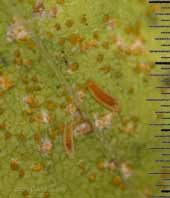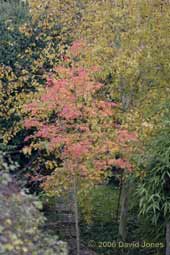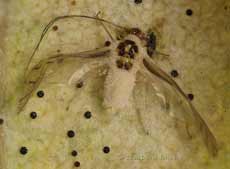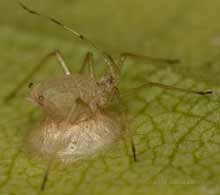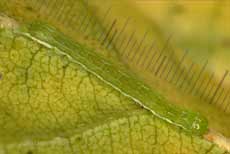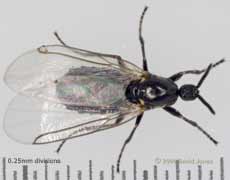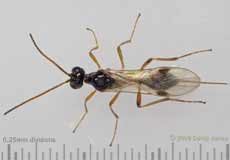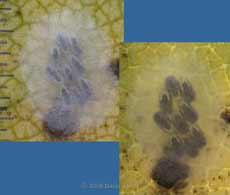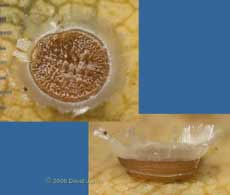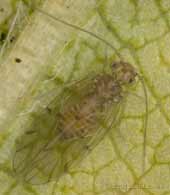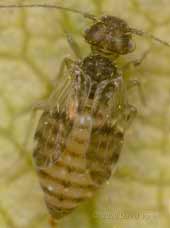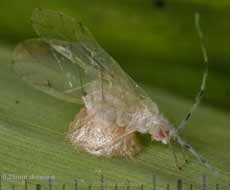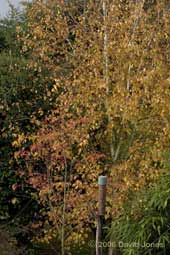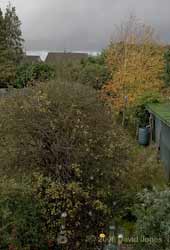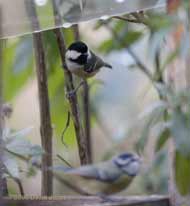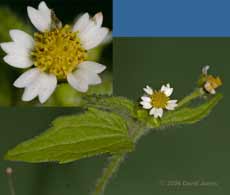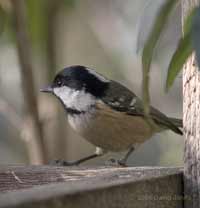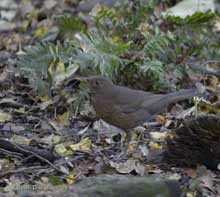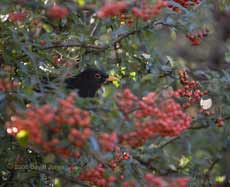Go to the last entry on this page .....Go to previous entry11 November - A fine, breezy day after a bit of rain last night which went just a little way towards topping up the pond. After yesterday's work in the garden I found myself hurting a bit this morning, but more annoyingly feeling as though I'd been punched in my right eye. While I was clearing the far end of the pond I was wearing long-sleeved gloves. At one point I felt something moving on my eyebrow, but with muddy hands I couldn't do anything about it. Later in the evening I noticed that my eyelid was a bit swollen, and this morning I could hardly open that eye. It's still swollen tonight, but not as badly. It's very annoying. up until then I hadn't been bitten at all this year, despite spending time down the garden nearly every even while we are at home. Anyway, it didn't stop me making an acrylic and glass platform to complete the macro stage (replacing the cornflakes packet cardboard!), and putting it to use.
While I cannot identify them, they do resemble hoverfly larvae. Like many of the leaves on the Birch, The leaf was close to being shed by the tree so I can only assume that these larvae are destined to complete their development amongst the leaf litter.
14 November - Over the last few days it has remained mild, with the lowest night time temperature only just dipping below 10C. My eye is now almost back to normal after the insect bite - at least it didn't itch!
Today (at 2pm) it is 14C under dull grey skies, and with light rain falling. However, the garden is brightened up by the contrasting colours of the Rowan and the Birch. Since I last photographed this view just four days ago, the leaves on the Birch have turned distinctly autumnal, almost golden against the deep greens of the Ivy and the Bamboo.
There are still a couple of Orange Ladybirds to be found on the Birch, as well as small numbers of Barkflies and aphids.
As the leaves prepare to fall, it is also possible to find insects that have fallen victim to fungi Here, a barkfly, surrounded by the fruiting bodies of the mildew that affects the birch leaves, has been used as a host by a fungus (probably Entophthora sp.), and has sporing structures covering its body. In this case an aphid has become firmly anchored to the underside of a leaf by what I first thought must be a cone of fungal mycelia. However, Phillipe Moniotte has let me know that it is likely instead to be a cocoon, produced as a result of the action of a parasitic Braconid wasp. The wasp injects an egg into the aphid, which carries on feeding until the parasitic larva inside completely consumes it. The fully grown larva than constructs the parchment like structure, and an adult wasp emerges a week or so later.
There are still surprises to be found on the yellowing leaves - for instance, this small caterpillar (The scale shown in the picture has 0.25mm divisions). I found it yesterday, and a search for further examples was unsuccessful. Today there is no sign of it anywhere along the branch.
The mild conditions seems to be encouraging small flies to appear around the composter, and this is one example. I cannot be sure of its identity, but its general shape, size and wing venation are very similar to Scatopse notata, which breeds in decaying matter.
This morning I had an opportunity to use the macro stage before breakfast after I spotted this small Ichneumon fly on the inside of our kitchen window. I often come across similar insects, but as there are so many species I cannot start to identify it.
After a few days of numerous Sparrowhawk attacks, I haven't seen it here once over the last three days. Things are getting back to normal around the feeders, and yesterday there were three Greenfinches here for a short time. There's no sign of them today, but as I write this there are eight Goldfinches tucking into the sunflower kernels and the Thistle seed. I've added a bit to the Canon 20D page in the Technical section of the website, giving details of the sub-stages I've made over the last week to go with the Zeiss stage, and which I have used for several of my latest photographs.
15 November - Despite a few glimpses of the sun around breakfast time, today has been another grey day, and dry, with a high of nearly 14C after a low of 11C last night. Before I launch into today's entry I first need to note that thanks to Phillipe Moniotte of Belgium I have needed to correct yesterday's entry about the aphid on the Birch leaf - it turns out that rather than a fungus being responsible for the aphid's demise, the culprit was more likely a parasitic wasp. I made the mistake of throwing the leaf back out into the garden yesterday evening, and I failed to find it again this morning to see if the adult wasp had already emerged. During the day I spent ages searching the Birch and the bamboo plants in the hope of finding another example. Unfortunately, while there were plenty of live aphids I wasn't successful. I did find a couple of other things of interest, and a Wren popped out of the bamboo and paused just a couple of feet in front of me before flying up into the conifers. Another good bit of bird news is that we have had an adult male Blackbird come to feed under the Hawthorn a couple of times during the day. While we get a female here regularly now, the male is still just an occasional visitor.
The right-hand picture was taken with light shining through the leaf. During the time the cocoon was under the lens I didn't see any movement inside it, so I assume that the nine shapes inside must still be developing eggs - I wait to be corrected!
My search of the leaves resulted in another strange discovery - just a single example of what looks like a miniature cup-cake, measuring just over 1mm across! Again, I can only assume at this moment that it is possibly a fungal fruiting body, but I need to investigate further.
This time I will keep the leaves to see what happens!
The leaves of the Birch and the bamboo also continue to have lots of Barkflies on them, some taken over by fungi like the one photographed yesterday, but most very much alive. I must spend some time trying to establish if there any species that I haven't already photographed. In the meantime this is one of the smallest that I find, first a healthy looking adult,
and then this individual, the same size as the first, but darker and with what appear to be stunted wings (unless it it is newly emerged, and the wings have yet to expand?).
While the Birch tree looks even more golden today, during my search, every time I handled a branch, a leaf fell to the ground. It will not be long before the tree loses most of its foliage.
16 November - A really miserable, dim and damp start to the day. After a very mild night with a high(!) of over 13C the temperature has been dropping since I got up - it was 11C at 9am and was below 10C at 11am. Over the last few months the Goldfinches have favoured the sunflower kernels. However, watching the birds this morning, it's interesting to note how they tend to prefer the thistle seed at the moment. We have just had breakfast visits by a Coal Tit, a Long-tailed Tit and a Great Tit, and a little bit later the Sparrowhawk made an appearance, although she didn't land and seemed to leave without anything in her grasp.
I cannot see any signs of a wasp having emerged so it is now in a container and I will be checking on it over the days to come. Look carefully at the large image and you may see a fuzziness around the head which suggests that the body is also host to a fungus.
17 November - Last night was colder, down to 5C. Tonight at 9pm it is 6C under a starry sky, after the temperature got up to 11C in the middle of the wettest day we have had for a long time. It wasn't a day for doing anything in the garden, and photographs were taken from the shelter of the house (even the veranda was soaked today!)
First of all, the Birch tree again. It has now acquired a very distinctive orange colour, and so has the ground beneath it as the squally weather strips it of its leaves. The Rowan has lost a greater proportion of its foliage and is now less distinct in front of the Birch.
At the other end of the garden, the Hawthorn has now lost most of its leaves, without the spectacular colour changes.
It was really to dim to take any worthwhile bird pictures today, but here is one shot for the record of the Coal Tit as it waited its turn at the table. It returned numerous times during the morning.
This afternoon I needed to go to our local sub-post office. I decided to walk there during a lull in the rain, and then met the heaviest rain of the day as I started back! Nevertheless, some plants growing out of the cracks at the side of the pavement caught my eye as they had lots of small, unfamiliar flowers on them. I pulled out one small plant and brought it home.
The hairs on the flower stalks have small globules at their ends - Perhaps I will collect a couple more tomorrow to take some closer photographs.
18 November - In dramatic contrast to yesterday, I don't think there has been hardly a cloud in the sky today, and it has been colder. There was ice on the roof of the Discovery this morning, and the temperature stopped short of 9C during the afternoon. I'm afraid that I didn't make it out to collect more of the Shaggy Soldier plants - I try again in the next day or two. Here in the garden, the morning sunshine brought out a Red Admiral which spent time sunbathing on the highest fronds of a bamboo plant. Nearer ground level I caught sight of a Wren visiting the foliage of the big pond, but not near enough to photograph it.
The Coal Tit was here frequently throughout the day. It makes very brief visits to the bird table, and this was the nearest I got to a clear image of it. Unfortunately I didn't use a tripod and I couldn't avoid camera shake, which was a pity.
It's interesting to compare the two Blackbirds that are visiting at the moment. The female feeds exclusively on the ground,
while the male did all his feeding up on the Pyracantha. At the rate he consumed them today it won't be long before the bush is stripped. I shall be trying again to get a picture of the male with a berry in his beak. Click on the images to see larger versions - |
September trip
to
Cornwall
|
